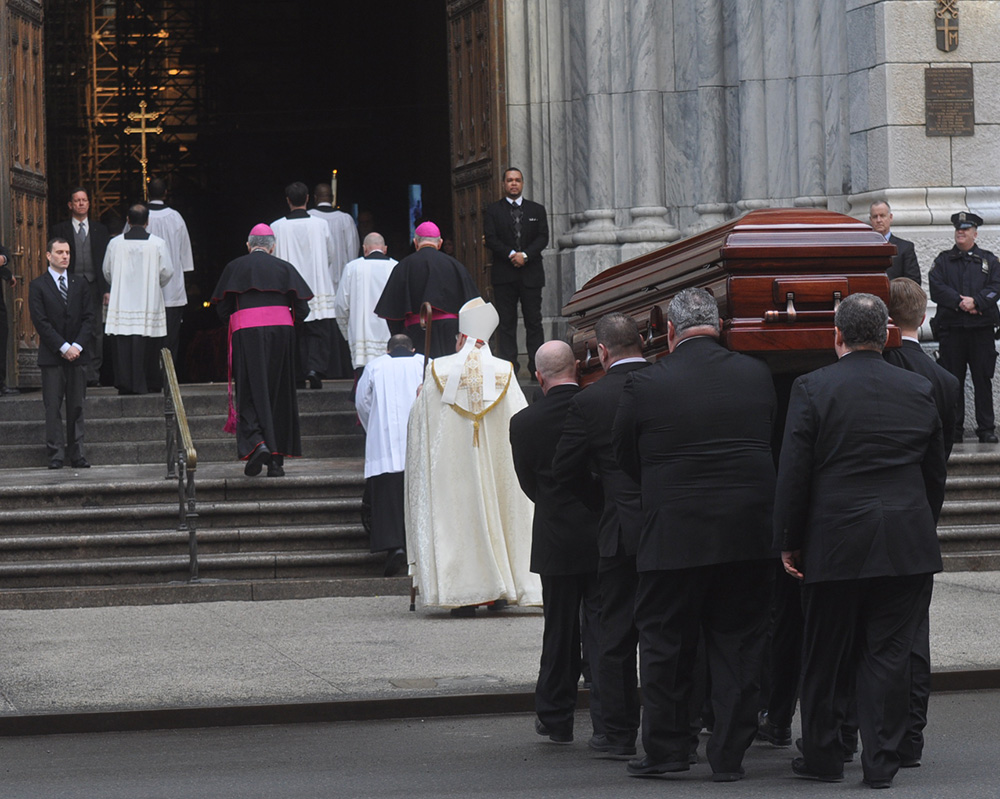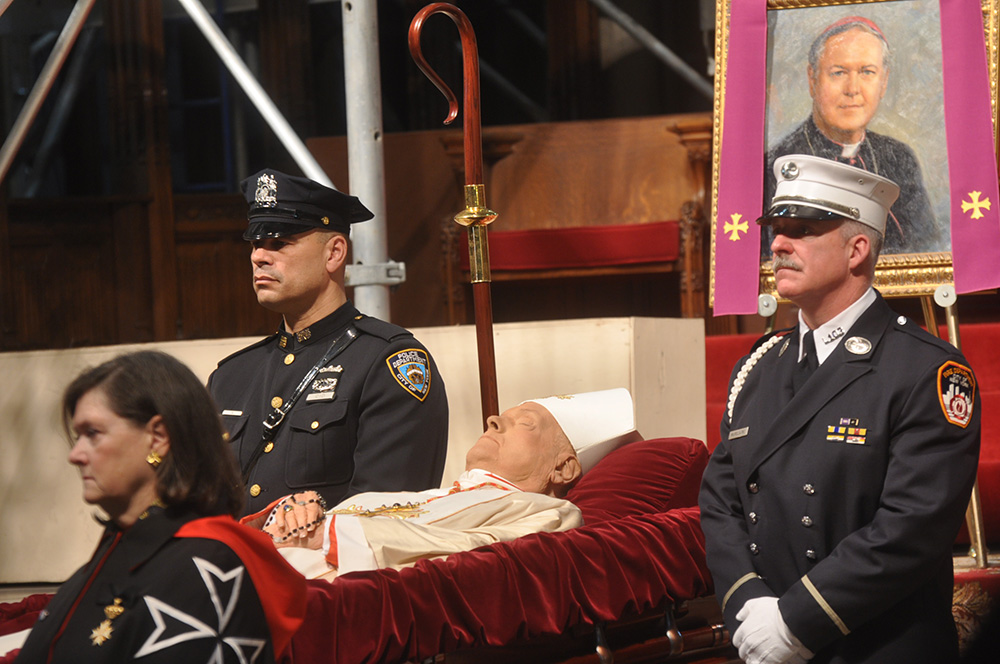
Cardinal Edward M. Egan, who retired as archbishop of New York in 2009, died March 5. The cause of death was cardiac arrest. He was 82.
After collapsing at his residence that afternoon, he was taken to NYU Langone Medical Center, where doctors pronounced him dead at 2:20 p.m.
A Mass of Christian Burial was conducted March 10 at St. Patrick’s Cathedral with eight cardinals and scores of bishops in attendance as well as Gov. Andrew Cuomo, Mayor Bill de Blasio and former Mayors Rudy Giuliani, Michael Bloomberg, and David Dinkins. (Video report.)
Cardinal Timothy M. Dolan told Catholics of the archdiocese he was saddened to tell them “our beloved” Cardinal Egan “has gone home to the Lord.”
“Join me, please, in thanking God for his life, especially his generous and faithful priesthood. Pray as well that the powerful mercy of Jesus, in which our cardinal had such trust, has ushered him into heaven,” said Cardinal Dolan, who succeeded Cardinal Egan.
“My sympathy to his natural family, who will grieve for their uncle, and to you, his spiritual family here in the Archdiocese of New York,” he added.
Cardinal Dolan in his statement said that Cardinal Egan “had a peaceful death, passing away right after lunch today, with the prayers and sacraments of his loyal priest secretary, Father Douglas Crawford, in his residence at the Chapel of the Sacred Hearts of Jesus and Mary.”
He said the retired archbishop was rushed from the residence to the nearby medical center, where he was pronounced dead.
In a telegram to Cardinal Dolan, Pope Francis offered his heartfelt condolences.
“I join you in commending the late cardinal’s noble soul to God, the father of mercies,” the pope said, “with gratitude for his years of episcopal ministry among Christ’s flock in Bridgeport (Connecticut) and New York, his distinguished service to the Apostolic See, and his expert contribution to the revision of the church’s law in the years following the Second Vatican Council.”
Bishop Nicholas DiMarzio, speaking to Currents, the daily cable news show on The NET, said: “He did a lot of other things he had to do, administration, which was one of them. But he really was a pastor. As Cardinal Dolan said he was out every Saturday night or every Sunday he could be to a parish, making a visitation, doing a Confirmation. He wanted to be with God’s people.”
Bishop DiMarzio recalled that after his own installation as Bishop of Brooklyn in 2003, “there was a picture that was in the paper and both of us were laughing. My friends asked me what was so funny. It was just a joyful occasion and we were getting along. So, it was really nice.”

Auxiliary Bishop Raymond Chappetto recalled that Cardinal Egan was “a wonderful priest, a wonderful bishop and a great cardinal for our City of New York. And, I will miss him.
“He knew the changes that he had to make and he was not afraid to make them. And he did it with as much pastoral love as he could.
“The river was no problem for him. He had no problem crossing the river to come to Brooklyn and whenever he came, he always admired our diocese, respected our diocese and felt at home here among us.”
Bishop DiMarzio also recalled that at the dedication of St. Joseph Co-Cathedral, Prospect Heights, last spring, Cardinal Egan noticed “a statue of St. Edward the Confessor, his patron, which is rather rare. There is not too many of those statues around. And he went over to investigate it and he really liked it.”
At the time, Cardinal Egan remarked, “I will be coming over here as often as you invite me to this wonderful Diocese of Brooklyn.
“The diocese is powerful in every way. It’s New York at its best. It’s the Church at its best. It’s America at its best. God love you and congratulations.”
Joseph Zwilling, director of communications for the Archdiocese of New York, recalled the cardinal’s fondness for Brooklyn.
“There was a very real closeness and he loved working with Bishop (Thomas V.) Daly and he loved working with Bishop DiMarzio,” said Zwilling. “He loved that relationship that we had and there’s so many areas of common interest that we had to work on together and he always looked for the Bishop of Brooklyn and made sure they were involved and made sure we were working together for a common goal.”
One of the first people to pay his respects at the public viewing was Brooklyn State Sen. Martin Golden, who said Cardinal Egan “led the way and showed how we could keep our diocese alive and breathing and bring life into people when they believed they were dying. Now there are people coming back to our churches and our schools, and there are the different funds that are being raised to educate our children and keeping the flock together. I think he did an outstanding job and he’ll have a great legacy.”
A former auxiliary bishop of New York, then-Bishop Egan was named to head the Diocese of Bridgeport in 1988 and was appointed as archbishop of New York in 2000. He was named a cardinal in 2001.
In retirement, Cardinal Egan assisted in the works of the New York Archdiocese. For the Vatican, he served on the Council of Cardinals for the Study of the Organizational and Economic Problems of the Holy See for five years and participated in the 2005 conclave that elected Pope Benedict XVI.
With his death, the College of Cardinals now has 226 members, 125 of whom are under 80 and therefore eligible to vote in a conclave to elect a new pope.
At the U.S. Conference of Catholic Bishops, Cardinal Egan was a current member of the Committee on Migration and a consultant to the Committee on Pro-Life Activities, as well as a member of the board of bishops for the Pontifical North American College in Rome.
Edward Michael Egan, the son of Thomas J. and Genevieve Costello Egan, was born April 2, 1932, in Oak Park, Ill.
He earned a bachelor’s degree in philosophy from St. Mary of the Lake Seminary in Mundelein, Illinois; a licentiate in theology from the Pontifical Gregorian University in Rome; and a doctorate summa cum laude in canon law, also from the Gregorian.
He was ordained a priest of the Chicago Archdiocese Dec. 15, 1957, at the North American College, in a ceremony that also included J. Francis Stafford, another future cardinal. After further studies in Rome, he returned to Chicago in 1958 to serve as parochial vicar of Holy Name Cathedral Parish, assistant chancellor and secretary to Cardinal Albert G. Meyer.
Back in Rome for doctoral studies from 1960 to 1964, he also served as assistant vice rector of the North American College. Again in Chicago from 1965 to 1972, he was secretary to Cardinal John P. Cody, archdiocesan vice chancellor and co-chancellor for ecumenism and social relations.
Named an auditor of the Roman Rota, the Vatican tribunal primarily responsible for hearing requests for marriage annulments, in November, 1972, then-Father Egan also was a professor of civil and criminal procedure at the Studio Rotale and of canon law at the Gregorian; commissioner of the Vatican Congregation for Divine Worship and the Sacraments; a consultor to the Vatican Congregation for Clergy; and, in 1982, one of six canonists who reviewed the new Code of Canon Law with St. John Paul II before it was promulgated in 1983.
Appointed an auxiliary bishop in New York April 1, 1985, he was transferred to Bridgeport Nov. 5, 1988, and named archbishop of New York May 11, 2000. He retired in May, 2009 at age 77; canon law requires bishops to turn their resignation into the pope at age 75.
Cardinal Egan was the first head of the New York Archdiocese to retire from the post. The three bishops and eight archbishops who preceded him all died in office.
